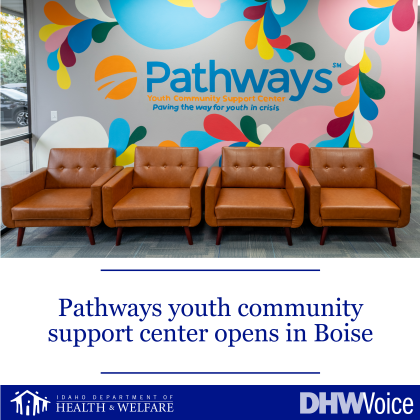The vision of the Department of Health and Welfare’s Get Healthy Idaho plan is healthy people living and thriving in safe, healthy, and resilient communities. Differences in communities and neighborhoods can impact how long and how well people live. Get Healthy Idaho is a creative, place-based approach that supports communities at the local level to make sure everyone has the opportunity to be healthy.
One of the best ways to support health and well-being in communities is to shift decision-making to those who live and work there. Get Healthy Idaho understands that each community has different needs and strengths, and it creates the ability for communities to come together to create shared goals for improving health.
Strategies may include changes to policies, systems, and environments that improve access to jobs, healthy and nutritious foods, places to be physically active, and available healthcare, for example. These solutions can improve economic and community well-being. They may also improve the community’s ability to overcome challenges in the future. When efforts that focus on prevention are successful, people are healthier, more productive, and are more connected and invested in the community’s health. The entire community grows stronger.
The Division of Public Health in the Department of Health and Welfare has been investing in Elmore and Bannock counties since 2021 to help build strong local partnerships focused on a shared goal. These are referred to as collaboratives. In their first year of funding, each collaborative worked with community members to identify local priority health needs. From there they will build action plans with solutions to improve the health of their community members, including those who are underserved.
Since the solutions are local, they are much more likely to create positive, long-term change. The Division of Public Health provides funding, technical assistance, resources, and tools for four years in each awarded community
Congratulations to the Clearwater Economic Development Association
In September, the Clearwater Economic Development Association (CEDA) in North Central Idaho became the newest Get Healthy Idaho community. CEDA will receive $100,000 per year for four years to build partnerships, collect data from residents to understand local health needs, identify health priorities, develop an action plan, and implement local health solutions.
CEDA has a long history of leadership and the strong regional connections needed to build the collaborative. CEDA’s work will be focused on improving health for Idahoans in Kamiah and Orofino. The proposal received support from both city governments, Kamiah High School, Clearwater and Lewis County commissioners, North Central Idaho Public Health District, St. Mary’s and Clearwater Valley Health, Community Action Partnership, LC Valley Healthcare Foundation, Idaho Food Bank, and others. Read CEDA’s Get Healthy Idaho announcement.
Health improvements continue in Elmore and Bannock counties
While work is just starting in Kamiah and Orofino, the United Way of Southeastern Idaho in Bannock County is gearing up to start its third year of the initiative. The Western Idaho Community Health Collaborative (WICHC) in Elmore County has started its fourth and final year of funding this month.
The United Way of Southeastern Idaho was awarded funds in October 2021, and is focused on improving health for underserved residents of Bannock County. Community surveys and conversations with residents helped the collaborative identify transportation as a major barrier to health. Due to strong partnerships with health clinics and a local transportation ride service, a point-to-point transportation solution for community members was borne. This program is known as Ride United. Through the service, riders have access to healthcare, behavioral health, recovery support, and other services provided at the Portneuf Medical Center’s City Center Campus in Pocatello. Ride United is joined with FindHelpIdaho.org and allows case managers to order rides that help community members access the services they need when they need to be there.
Between January and July 2023, more than 1,270 rides were provided to community members for doctors’ appointments at the free clinic, recovery programs and resources, and crisis center support, among other health services. Watch this video to learn more about the service from a rider. Listen to United Way of Southeastern Idaho’s new podcast, Igniting Change, Episode 3 (available late October), focused on the impact of Get Healthy Idaho investments in Bannock County.
In addition, United Way partnered with Southeast Idaho Council of Governments to help residents with transportation barriers learn how to use the Pocatello bus system so they can manage their own transportation needs. Ride United helps clients get to the care they need at the Pocatello Free Clinic, the Southeast Idaho Behavioral Crisis Center, and the Hope and Recovery Resource Center, among other services.
In October, Ride United was recognized as an innovative idea by the National Aging and Disability Transportation Center. The center promotes transportation options for older adults, people with disabilities, and caregivers.
Because of these new transportation options, no-show rates at the free clinic dropped to zero. This service helps clinicians provide better care for their patients, helping them achieve healthier outcomes. When asked about the impacts of Ride United on their clients, Matt Hardin, former director of Southeast Idaho Behavioral Crisis Center, said, “Ride United was the second most important thing that positively impacted us next to the Medicaid expansion in 2020.”
In southwest Idaho, the very first Get Healthy Idaho funded community in Elmore County continues planning, development, and collaboration efforts with county-wide partners to bring their community action plan to life. This work is led by The Western Idaho Community Health Collaborative (WICHC). With community input, the action plan addresses Get Healthy Idaho priorities (diabetes, obesity, unintentional injury, and behavioral health) by improving access to public lands and open space, increasing transportation options, and enhancing access to healthcare services and behavioral health support.
To increase access to care across the county, WICHC is working with Desert Sage Health Centers to implement a Community Health Worker (CHW) program. They are also partnering with Elmore Ambulance Service to pilot a Community Health-Emergency Medical Services (CHEMS) program to improve care for residents with behavioral health needs or diabetes.
The CHEMS program in Elmore County was officially launched in September. CHEMS paramedics focus on patients’ health in non-emergency settings, outside the hospital. CHEMS prevent future health emergencies by visiting patients in their homes. The program increases access to primary and preventive care services and decreases the use of emergency departments for patients with chronic diseases and complicated care plans. They make sure patients have the tools, education, and support they need to treat medical conditions and maintain their health.
This summer, Dr. Jennifer Rhoads was hired by Elmore Ambulance Service to lead the CHEMS program for the county. She has begun visiting patients with complex health needs, helping make their homes safer by fixing hazards that can lead to falls, teaching caregivers how to dress wounds, help them understand how to take medication, and treatment of chronic disease. This work is important because it prevents them from ending up sick or in the hospital.
While they have begun their fourth and final year of Get Healthy Idaho, WICHC partners and Dr. Rhoads are making lasting improvements in access to healthcare options as well as improving overall mental and physical health for residents in Elmore County who need it most.
Sustained investment toward shared goals transforms communities
Health happens where people live, work, and play. The policies, systems, and environmental solutions to improve health for all people should reflect the unique needs and culture of each community. By shifting to community-led models, and through continued investments from funders, such as Get Healthy Idaho, communities can work together to address their unique health challenges and achieve shared goals that will result in a healthy, thriving, resilient community.
Learn more about these community-based initiatives as part of the state’s Get Healthy Idaho Plan at https://www.gethealthy.dhw.idaho.gov/.
Katie Lamansky manages the Get Healthy Idaho Initiative in Idaho’s Division of Public Health. She has worked for the division since 2008, where she started her career as a health program specialist in the Idaho Physical Activity and Nutrition Program. Katie supports GHI through strategic leadership and programmatic oversight to achieve Get Healthy Idaho’s vision of healthy people, living and thriving in safe, healthy, and resilient communities.
The Idaho Department of Health and Welfare is dedicated to strengthening the health, safety, and independence of Idahoans. Learn more at healthandwelfare.idaho.gov.




Join the Discussion
Please note the following terms of participation in commenting on the DHW Voice blog.
To ensure a productive discussion you agree to post only comments directly related to this post and to refrain from posting obscenities; threatening, abusive or discriminatory language; sexually explicit material; and other material that would violate the law if published here; promotional content; or private information such as phone numbers or addresses. DHW reserves the right to screen and remove inappropriate comments.